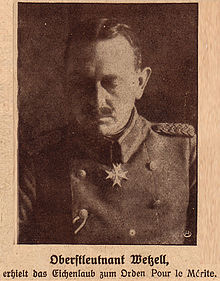Georg Wetzell
General der Infanterie Georg Wetzell | |
|---|---|
 Lt-Col Georg Wetzell (1918) | |
| Chief of the Troop Office | |
| In office October 1925 – 27 January 1927 | |
| President | Paul von Hindenburg |
| Preceded by | Otto Hasse (general) |
| Succeeded by | Werner von Blomberg |
| Personal details | |
| Born | 5 March 1869 Nieder-Erlenbach, Oberhessen, Grand Duchy of Hesse |
| Died | 3 January 1947 (aged 77) Augsburg, Bavaria, Allied-occupied Germany |
| Awards | Pour le Mérite with Oak Leaves |
| Military service | |
| Allegiance | |
| Branch/service | |
| Years of service | 1889–1927 |
| Rank | General der Infanterie |
| Battles/wars | World War I |
Georg Wetzell (5 March 1869 - 3 January 1947) was a German General of the Infantry and from 1925 to 1927 chief of the Truppenamt (troop office) of the Reichswehr.
Biography
[edit]On 1 October 1889, Wetzell joined the Pioneer Battalion No. 16 of the Prussian Army in Metz as a Fahnenjunker and was promoted to second lieutenant by the end of August 1891. As such, he was transferred to the Pioneer Battalion No. 20, also stationed in Metz, on 1 October 1893, and attended the Unified Artillery and Engineering School for further training. In 1898 he was assigned to Infantry Regiment No. 144, in which he was promoted to Premierleutnant. From 1901 to 1903 Wetzell attended the Prussian Staff College and was then assigned to the General Staff.
After promotion to Major on 1 October 1912, he was assigned as Ia (first staff officer) to the staff of the III Army Corps on 22 March 1913. There he remained after the outbreak of World War I and from 9 March 1915 he served as the chief of staff of the III Army Corps. In August 1916 he was transferred to the Oberste Heeresleitung (OHL; Supreme Army Command) and appointed chief of the operations department of the General Staff of the Field Army. In this role he was responsible for planning several major German offensives of the war. On 11 December 1916 he received the Pour le Mérite.
In 1917 he worked closely with Erich Ludendorff who in his position as First Quartermaster General directed the German war effort. Wetzell was responsible for developing the plan for the Battle of Caporetto which resulted in a major victory for the Germans and their Austro-Hungarian allies over the Italians. For his achievements in planning the campaign against Italy he was awarded the oak leaves for Pour le Mérite on 1 November 1917.
In October 1917 Wetzell urged Ludendorff to attack in the early spring of 1918, before the American Expeditionary Forces arrived on the Western Front. On 11 November 1917 Wetzell accompanied Ludendorff to the Mons Conference for discussions with Crown Prince Rupprecht of Bavaria, the commander of Army Group A, and Crown Prince Wilhelm of Prussia, the commander of Army Group B, and their respective chiefs of staff, von Kuhl and von der Schulenburg.[1] Wetzell preferred to attack the French army, considering it the larger and more dangerous enemy. Ludendorff, however, decided to direct the attack against the British Expeditionary Force and accordingly ordered the planning for Operation Michael. Wetzell also planned the follow-on offensives, Operation Georgette and Operation Blücher.
At the end of September 1918 Wetzell was appointed Chief of Staff of the 5th Army. After the end of the war Wetzell served temporarily as Chief of Staff of the XVIII Army Corps and was taken over into the Reichswehr. In 1920 he was promoted to Colonel (Oberst).
In 1921 he was appointed inspector of the intelligence troops (In 7) in the Ministry of the Reichswehr and he was promoted to Generalmajor on 1 December 1923. On 1 February 1926 he was appointed Chief of the Troop Office and promoted to Generalleutnant on 1 February 1927. In April 1927 he was relieved of his post and transferred to the staff of Gruppenkommando I in Berlin. On 31 October 1927 he was retired with the rank of General of the Infantry. After his retirement he founded the military magazine Deutsche Wehr.
Starting in 1930 Wetzell worked for four years as a general advisor on military matters to the Chinese government in Nanking (see Sino-German cooperation (1926–1941)). He then worked as editor-in-chief of the newspaper Militär-Wochenblatt from 1 October 1934 until December 1942 when the paper was discontinued. He also worked as the author and editor of many military and political essays.
Bibliography
[edit]His works include:
- Von Falkenhayn zu Hindenburg-Ludendorff (1921)
- Der Bündniskrieg (1937)
- Die deutsche Wehrmacht (1939)
Sources
[edit]- Karl-Friedrich Hildebrand, Christian Zweng: Die Ritter des Ordens Pour le Mérite der I. Weltkriegs. Band 3: P–Z. Biblio Verlag, Bissendorf 2011, ISBN 3-7648-2586-3, S. 528–530.
- Hanns Möller: Geschichte der Ritter des Ordens pour le mérite im Weltkrieg. Band II: M–Z. Verlag Bernard & Graefe, Berlin 1935, S. 491–493.
References
[edit]- ^ Stevenson, David (2009). Cataclysm: The First World War as Political Tragedy. Basic Books. p. 327.
External links
[edit]- Literature by and about Georg Wetzell in the German National Library catalogue
- Georg Wetzell in der Online-Version der Edition Akten der Reichskanzlei. Weimarer Republik
- Nachlass Bundesarchiv N 629


 French
French Deutsch
Deutsch